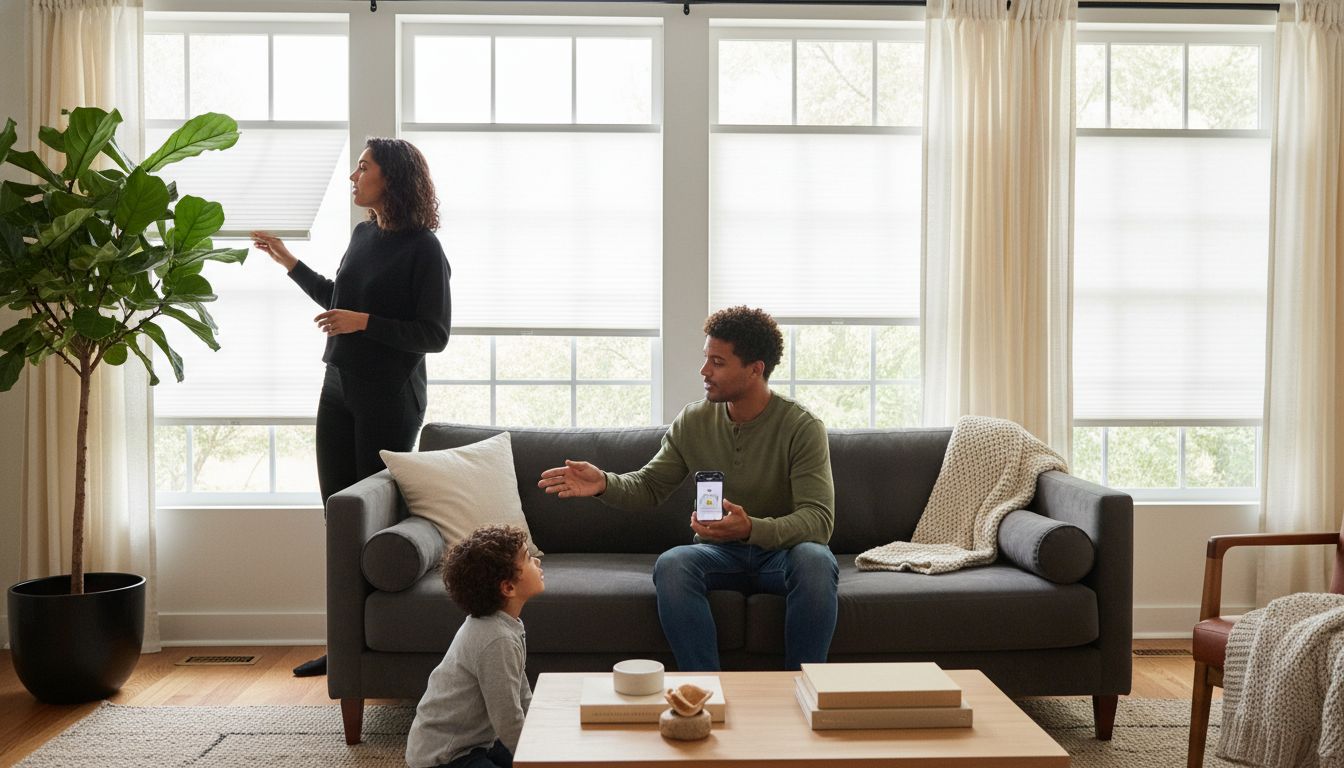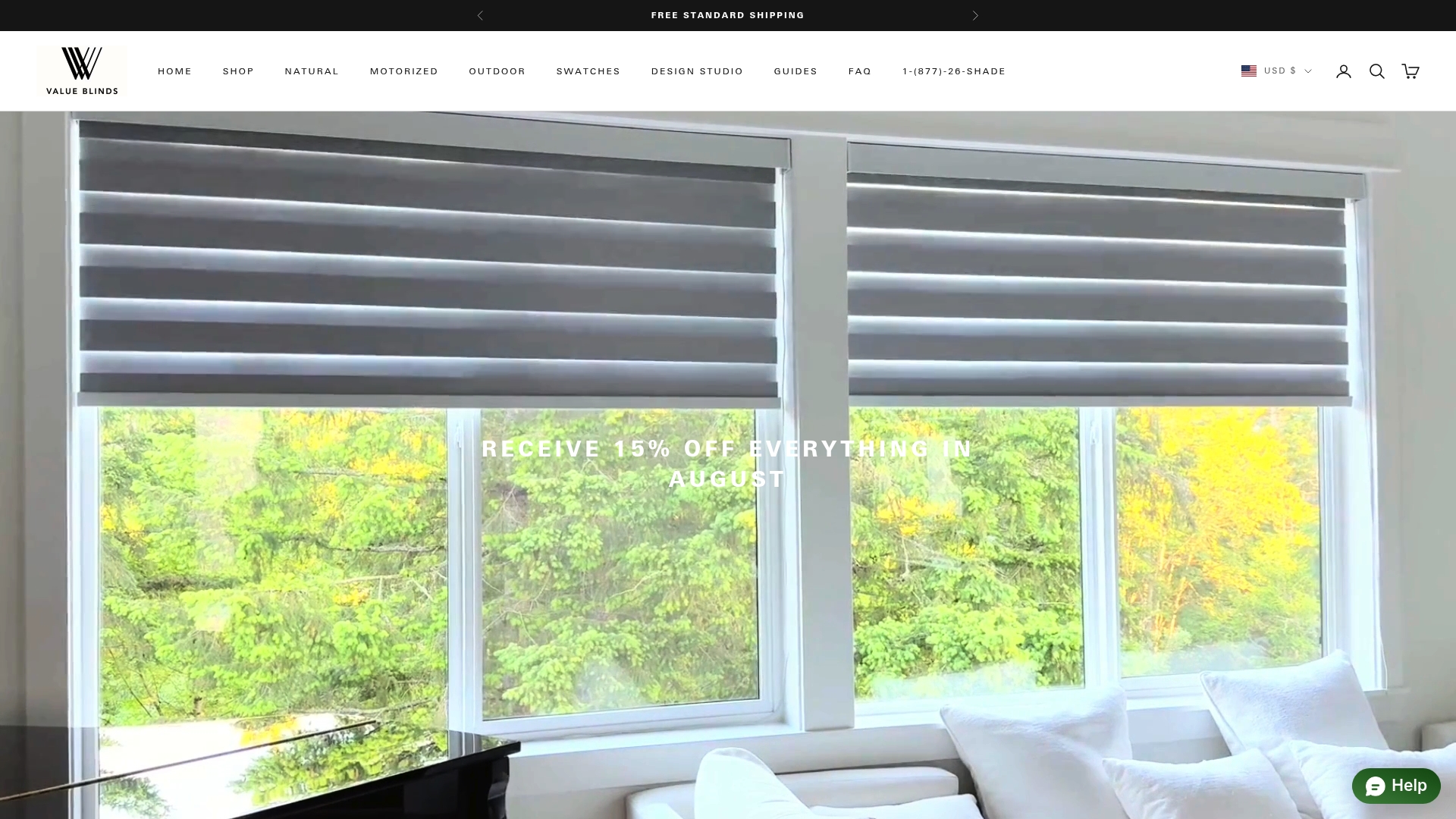
7 Essential Tips for Energy Efficient Window Coverings
Nearly one third of a home’s heating energy slips out through the windows each year. That means every uncovered window is quietly raising your utility bills and making your home less comfortable. Choosing the right window coverings is more than a style decision. It is a smart way to improve insulation, reduce energy loss, and save money by using materials and strategies proven to work. Discover how targeted window treatments can transform both your comfort and your energy savings.
Table of Contents
- Understand The Benefits Of Energy Efficient Window Coverings
- Choose The Right Material For Insulation
- Opt For Cellular Shades To Maximize Energy Savings
- Install Blackout Or Thermal Curtains For Added Efficiency
- Use Motorized Shades For Smart Energy Management
- Layer Window Treatments For Enhanced Performance
- Leverage Measurement Tools For A Perfect Custom Fit
Quick Summary
| Takeaway | Explanation |
|---|---|
| 1. Energy-efficient window coverings reduce bills. | These treatments can lower heating and cooling costs by minimizing energy loss throughout the year. |
| 2. Cellular shades offer superior insulation. | Their honeycomb structure traps air, significantly reducing heat transfer and enhancing temperature control in homes. |
| 3. Layering treatments enhances energy efficiency. | Combining different window coverings creates extra thermal barriers, improving insulation and reducing energy usage further. |
| 4. Choose the right materials for maximum savings. | Opt for thicker, multilayered fabrics to improve insulation and reduce energy loss effectively. |
| 5. Accurate measurements are crucial for fit. | Properly fitted window coverings prevent gaps that compromise insulation effectiveness, ensuring better energy performance. |
1. Understand the Benefits of Energy Efficient Window Coverings
Window coverings are more than just decorative elements they are powerful tools for managing your home’s energy performance. According to the U.S. Department of Energy, window coverings can significantly reduce energy loss which accounts for approximately 30% of a home’s heating energy.
These specialized window treatments work by creating an additional barrier against temperature fluctuations. In winter, they help retain interior heat and prevent warmth from escaping. During summer, they block solar heat gain and keep your living spaces cooler. This means you can maintain comfortable indoor temperatures while reducing your reliance on heating and cooling systems.
Key Benefits Include:
- Reduced energy consumption
- Lower utility bills
- Improved home comfort
- Enhanced temperature regulation
Research shows that affordable options like insulating cellular window shades can dramatically improve a home’s energy efficiency. The U.S. Department of Energy highlights that these window attachments not only save energy but also enhance overall home resiliency.
By investing in energy efficient window coverings, you are making a smart choice that benefits both your wallet and the environment. The initial investment quickly pays for itself through reduced energy costs and improved home comfort.
2. Choose the Right Material for Insulation
Not all window coverings are created equal when it comes to energy efficiency. The material you select can dramatically impact your home’s thermal performance and energy consumption. Oak Ridge National Laboratory research reveals substantial energy savings potential through strategic material selection.
Key Materials for Energy Efficiency:
- Cellular shades
- Thermal curtains
- Insulating roman shades
- Thick fabric window treatments
Cellular shades stand out as the top performer in material selection. Their unique honeycomb design creates air pockets that trap heat and provide superior insulation. According to the U.S. Department of Energy, these shades effectively block heat transfer and maintain consistent indoor temperatures.
When choosing materials, consider the thickness and layering. Multilayered fabrics with thermal backing offer additional protection against temperature fluctuations. Opt for materials that create natural air barriers and have tight weaves to minimize heat exchange.
Experimental testing shows that well-selected window covering materials can generate daily heating energy savings ranging from 17% to 36%. By investing in high-quality insulating materials, you are not just decorating your windows but creating a more energy efficient home environment.
3. Opt for Cellular Shades to Maximize Energy Savings
Cellular shades represent a game changing solution for homeowners seeking to reduce energy consumption and improve indoor comfort. Oak Ridge National Laboratory research demonstrates these innovative window coverings can achieve up to 24% heating energy savings in residential settings.
Why Cellular Shades Are Superior:
- Unique honeycomb structure traps air
- Provides exceptional thermal insulation
- Works effectively in both summer and winter
- Reduces heating and cooling costs
The distinctive honeycomb design creates multiple air pockets that act as natural insulators. These trapped air layers significantly reduce heat transfer through windows. According to technical research from the U.S. Department of Energy, cellular shades can generate incremental energy savings between 4.6% to 9.4% for cooling and over 20% for heating across different building types.
When selecting cellular shades, consider factors like cell size and fabric density. Larger cell sizes and thicker materials provide enhanced insulation. Choose light colors for summer to reflect heat and darker colors for winter to absorb warmth. By strategically installing cellular shades, you transform your windows from energy loss points into efficient thermal barriers.
4. Install Blackout or Thermal Curtains for Added Efficiency
Thermal curtains represent a powerful yet often overlooked solution for improving home energy efficiency. U.S. Department of Energy research reveals these specialized window treatments can reduce heat loss by up to 25% in winter and minimize heat gain by 33% during summer.
Key Benefits of Thermal Curtains:
- Exceptional temperature regulation
- Significant energy cost reduction
- Enhanced indoor comfort
- Multiple design and color options
The secret lies in their specialized construction. Thermal curtains typically feature multiple layers of dense fabric with special insulating backing that creates an effective barrier against temperature transfer. These curtains work by trapping air between window glass and fabric layers creating an additional insulation zone that prevents heat escape during cold months and blocks solar radiation during warm periods.
Oak Ridge National Laboratory acknowledges that various window coverings contribute to building thermal performance. When selecting thermal curtains, prioritize thick materials with tight weaves and consider light colored options for summer to reflect heat and darker tones for winter to absorb warmth. Professional installation and proper measurement ensure maximum energy efficiency and aesthetic appeal.
5. Use Motorized Shades for Smart Energy Management
Motorized shades represent the cutting edge of intelligent home energy management. U.S. Department of Energy research highlights their remarkable potential to optimize natural light and temperature control through automated programming.
Strategic Benefits of Motorized Shades:
- Automatic temperature regulation
- Precise light management
- Remote controlled convenience
- Integrated smart home functionality
These advanced window coverings can be programmed to respond to environmental conditions in real time. During winter months they can open during peak sunlight hours to capture natural warmth reducing heating costs. In summer they automatically close during intense afternoon sunlight preventing unnecessary heat gain and reducing cooling expenses.
Department of Energy technical reports suggest integrating motorized cellular shades with building automation systems can generate significant energy savings. Modern systems allow scheduling based on sunlight intensity temperature and even your personal preferences. Some advanced models connect with smartphone apps enabling you to control window treatments from anywhere providing unprecedented flexibility in managing your home’s energy efficiency.
6. Layer Window Treatments for Enhanced Performance
Layering window treatments is a strategic approach to maximizing energy efficiency and home comfort. U.S. Department of Energy recommends combining different window coverings to create multiple thermal barriers that reduce heat loss and gain.
Smart Layering Strategies:
- Combine cellular shades with draperies
- Mix thermal curtains with blinds
- Create air pockets between layers
- Use complementary materials and colors
The science behind layered window treatments involves creating trapped air spaces that provide additional insulation. By strategically combining different window coverings like cellular shades with heavy curtains, you can significantly improve your home’s thermal performance. Oak Ridge National Laboratory research suggests that multi-layer approaches offer superior energy savings compared to single window treatment solutions.
When designing your layered window treatments consider combining sheer and dense fabrics. Light filtering layers can help manage sunlight while thermal backing provides insulation. Experiment with different combinations to find the perfect balance between aesthetic appeal and energy efficiency. The goal is to create a dynamic window covering system that adapts to seasonal temperature changes and your specific comfort needs.
7. Leverage Measurement Tools for a Perfect Custom Fit
Accurate measurements are the foundation of effective energy efficient window coverings. U.S. Department of Energy emphasizes that precise measurements are critical to ensuring a snug fit that maximizes insulating properties and energy performance.
Essential Measurement Strategies:
- Use digital measuring tools
- Measure width at three points
- Account for mounting depth
- Consider window frame variations
- Double check all measurements
Precision matters more than you might think. Oak Ridge National Laboratory research demonstrates that improperly fitted window coverings can significantly reduce thermal performance. Even a small gap can compromise the insulating effectiveness of your chosen window treatment.
When measuring, start by using a metal tape measure for accuracy. Measure the width at the top middle and bottom of your window to account for any irregularities. For inside mount treatments measure the exact width and depth of the window frame. For outside mount treatments add extra width to ensure complete coverage and maximum light blocking. Professional measurement guides can provide additional detailed instructions to help you achieve the perfect fit.
Below is a comprehensive table summarizing the benefits, materials, strategies, and effectiveness of energy efficient window coverings discussed in the article.
| Topic | Description | Benefits/Expected Results |
|---|---|---|
| Energy Efficient Window Coverings | Window coverings reduce energy loss, accounting for 30% of a home’s heating energy. | Lower utility bills, improved home comfort, reduced energy consumption. |
| Material Selection | Choosing the right materials like cellular shades and thermal curtains impacts energy efficiency. | Enhanced temperature regulation and significant energy savings. |
| Cellular Shades | Feature a honeycomb design to trap air, offering superior insulation. | Up to 24% heating energy savings and reduced cooling costs. |
| Thermal Curtains | Specially constructed with insulating backing to reduce heat transfer. | Reduce heat loss by 25% in winter and minimize heat gain by 33% in summer. |
| Motorized Shades | Automate light and temperature control for smart energy management. | Automatic regulation, convenience, and significant energy savings. |
| Layered Treatments | Combining different treatments creates multiple thermal barriers. | Superior energy savings and adaptability to seasonal changes. |
| Measurement Strategies | Accurate measurements ensure a snug fit for maximizing insulation. | Optimal insulating properties and enhanced energy performance. |
Upgrade Your Home with Energy Efficient Window Coverings Today
Feeling frustrated by high energy bills and drafty rooms? The key to solving these challenges lies in smart window treatment choices. This article highlights the power of insulation, from cellular shades’ honeycomb design to thermal curtains that block heat loss and gain. Imagine transforming your windows into energy-saving champions that keep your home comfortable year-round while lowering utility costs.

Discover a wide range of customizable options at Value Blinds designed to fit your needs and style. Explore our Trending Features like blackout and motorized shades for smarter light and temperature control. Need the latest innovative designs? Check out our New Arrivals for fresh styles that combine energy efficiency with beauty. Take control of your home’s comfort and savings now by visiting Value Blinds and finding the perfect energy-efficient window coverings tailored for you.
Frequently Asked Questions
How do energy efficient window coverings reduce energy costs?
Energy efficient window coverings can significantly lower your energy bills by reducing heating and cooling demands. By blocking heat transfer and maintaining even indoor temperatures, these coverings can help you save approximately 20% on your energy costs.
What materials should I choose for the best insulation in window coverings?
Selecting materials like cellular shades, thermal curtains, and insulating roman shades will provide the best thermal performance. Look for multilayered fabrics with thermal backing to enhance insulation and reduce overall energy loss.
How can I determine the right size for energy efficient window coverings?
To ensure a snug fit that maximizes insulation, measure your windows accurately by getting the widths at the top, middle, and bottom. Use a metal tape measure and double-check all measurements to prevent gaps that can reduce efficiency.
What are the benefits of layering window treatments for energy efficiency?
Layering window treatments helps create multiple thermal barriers, improving insulation and reducing energy loss. Combine different types of coverings, such as cellular shades with heavy curtains, to boost energy savings by up to 30%.
How can motorized shades enhance my home’s energy efficiency?
Motorized shades automate temperature control and light management, optimizing energy use throughout the day. Program them to open during sunny hours in winter and close during peak sunlight in summer, potentially reducing energy costs by about 20%.
What is the impact of different window covering colors on energy efficiency?
Colors affect energy performance by influencing heat absorption and reflection. Lighter colors reflect heat during summer, while darker colors can absorb warmth in winter, so choose accordingly to maximize seasonal comfort and energy savings.







